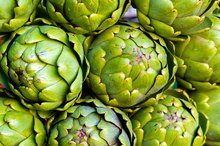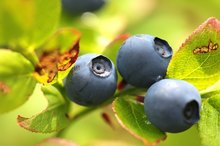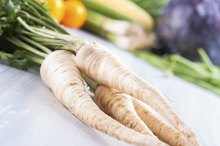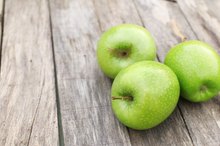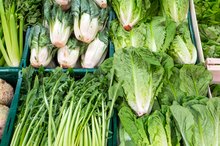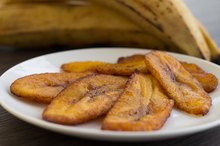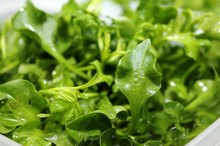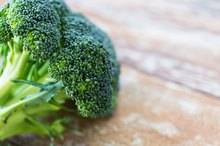What does fact checked mean?
At Healthfully, we strive to deliver objective content that is accurate and up-to-date. Our team periodically reviews articles in order to ensure content quality. The sources cited below consist of evidence from peer-reviewed journals, prominent medical organizations, academic associations, and government data.
The information contained on this site is for informational purposes only, and should not be used as a substitute for the advice of a professional health care provider. Please check with the appropriate physician regarding health questions and concerns. Although we strive to deliver accurate and up-to-date information, no guarantee to that effect is made.
Green Leafy Vegetables High in Potassium
Potassium is an indispensable nutrient -- not only does it facilitate normal nerve, muscle and organ function, but it also counteracts sodium and protects against high blood pressure. Despite these major health benefits, however, potassium intake in the United States falls far short of the recommended 4,700 milligrams a day. Including green leafy vegetables in your diet is an easy way to get more potassium, as they tend to be excellent sources.
Beet Greens
The next time you buy a bunch of beets, don’t discard the leafy tops -- these dark tender greens are more nutritious than the bright red root. Beet greens are one of the most potassium-rich foods you can eat -- a 1-cup serving of the cooked vegetable delivers 37 percent of the recommended daily value, according to the USDA National Nutrient Database 234. Cooked beet greens are an excellent source of vitamins A, C and K, as well.
Swiss Chard
What Vitamins or Minerals Are in Artichokes?
Learn More
Given that chard and beets are closely related, it’s no surprise that Swiss chard packs the same kind of nutritional punch. Swiss chard is set apart from other large-leaf greens by a white -- or red, pink, yellow, orange or purple, as the case may be – edible stalk. The mild-tasting vegetable is an excellent source of potassium, providing 27 percent of the recommended daily value per cup of cooked greens. It also supplies more iron than most greens.
- Given that chard and beets are closely related, it’s no surprise that Swiss chard packs the same kind of nutritional punch.
- The mild-tasting vegetable is an excellent source of potassium, providing 27 percent of the recommended daily value per cup of cooked greens.
Amaranth Leaves
Amaranth is primarily cultivated for its tiny nutrient-dense seeds, which have been touted as the “miracle grain” of the ancient Aztecs, according to "Wellness Foods A to Z: An Indispensable Guide for Health-Conscious Food Lovers." The plant’s tender green leaves are just as nutritious as its seeds, however, and are widely available at health food stores and farmer’s markets 9. According to the USDA, you’ll get 24 percent of the daily value for potassium from a 1-cup serving of cooked amaranth leaves. You’ll also get substantial amounts of calcium, iron, vitamin C and folate.
- Amaranth is primarily cultivated for its tiny nutrient-dense seeds, which have been touted as the “miracle grain” of the ancient Aztecs, according to "Wellness Foods A to Z: An Indispensable Guide for Health-Conscious Food Lovers."
- According to the USDA, you’ll get 24 percent of the daily value for potassium from a 1-cup serving of cooked amaranth leaves.
Spinach
Potassium in Kale
Learn More
Spinach is arguably the most nutritious green leafy vegetable in the average American diet. Spinach is from the same family as beets and chard, and like its botanical cousins, it’s a low-calorie source of several vitamins and minerals, including potassium -- a 1-cup serving of the cooked vegetable supplies 24 percent of the recommended daily value, according to the USDA. You’ll get the same amount of potassium from a serving of cooked taro leaves, which are often marketed as Tahitian spinach.
Considerations
Cooked greens are far more concentrated by volume than uncooked greens, which is why the raw variety doesn’t generally pack enough potassium per serving to qualify as an excellent source. Leafy greens also become more concentrated when they’re frozen. According to the USDA National Nutrient Database, a 1-cup serving of fresh cooked kale provides just 8 percent of the daily value for potassium, whereas kale that was frozen prior to cooking supplies 12 percent of the recommended daily value per serving 234. (ref 7, 8)
Related Articles
References
- Linus Pauling Institute at Oregon State University: Potassium
- USDA National Nutrient Database: Beet Greens, Cooked, Boiled, Drained, Without Salt
- USDA National Nutrient Database: Chard, Swiss, Cooked, Boiled, Drained, Without Salt
- USDA National Nutrient Database: Amaranth Leaves, Cooked, Boiled, Drained, Without Salt
- USDA National Nutrient Database: Spinach, Cooked, Boiled, Drained, Without Salt
- USDA National Nutrient Database: Taro, Tahitian, Cooked, Without Salt
- USDA National Nutrient Database: Kale, Cooked, Boiled, Drained, Without Salt
- USDA National Nutrient Database: Kale, Frozen, Cooked, Boiled, Drained, Without Salt
- Wellness Foods A to Z: An Indispensable Guide for Health-Conscious Food Lovers; Sheldon Margen, M.D.
- Chard, raw. FoodData Central. U.S. Department of Agriculture. Published April 1, 2019.
- Di Noia J. Defining powerhouse fruits and vegetables: A nutrient density approach. Prev Chronic Dis. 2014;11:E95. doi:10.5888/pcd11.130390
- Panche AN, Diwan AD, Chandra SR. Flavonoids: An overview. J Nutr Sci. 2016;5:e47. doi:10.1017/jns.2016.41
- Pollock RL. The effect of green leafy and cruciferous vegetable intake on the incidence of cardiovascular disease: A meta-analysis. JRSM Cardiovasc Dis. 2016;5. doi:10.1177/2048004016661435
- Morris MC, Wang Y, Barnes LL, Bennett DA, Dawson-Hughes B, Booth SL. Nutrients and bioactives in green leafy vegetables and cognitive decline: Prospective study. Neurology. 2018;90(3):e214-e222. doi:10.1212/WNL.0000000000004815
- Mohamed NA, Pineda De La Losa F, Castillo Fernandez M, Echechipla Madoz S, Zavala Segovia MJ, Tabar Purroy AI. Rhinoconjunctivitis induced by exposure to Swiss chard. J Allergy Clin Immunol. 2019:143(2 Supp):AB75. doi:10.1016/j.jaci.2018.12.232
- American Academy of Allergy Asthma and Immunology. Oral allergy syndrome (OAS) or pollen fruit syndrome (PFS).
Writer Bio
Based just outside Chicago, Meg Campbell has worked in the fitness industry since 1997. She’s been writing health-related articles since 2010, focusing primarily on diet and nutrition. Campbell divides her time between her hometown and Buenos Aires, Argentina.
